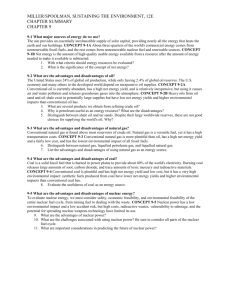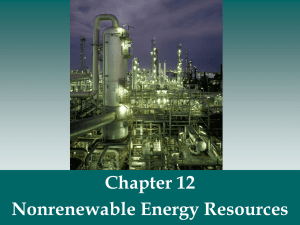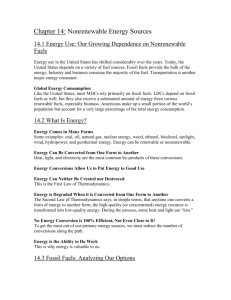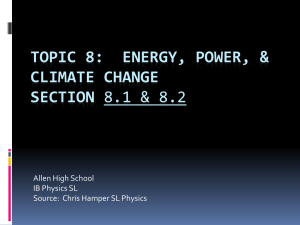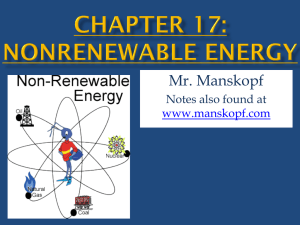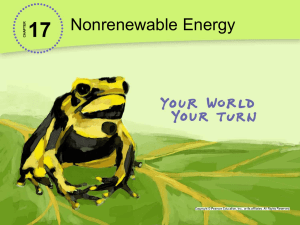Chapter 12_lecture
advertisement
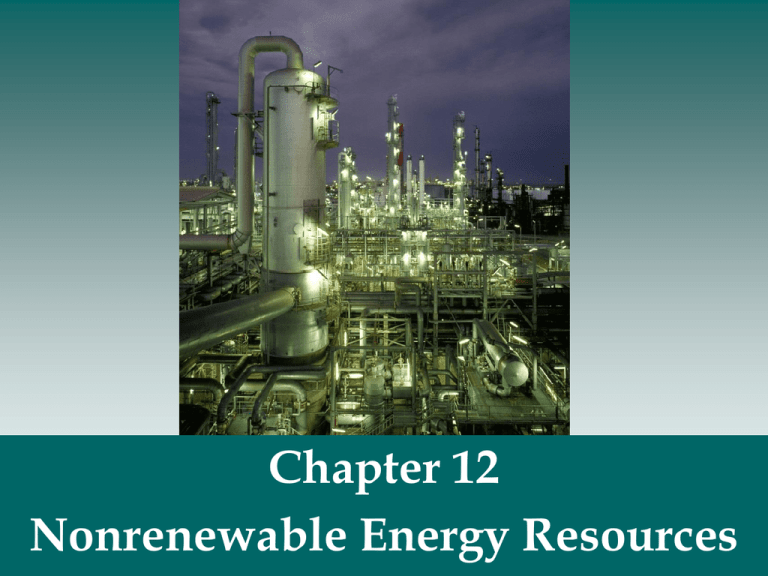
Chapter 12 Nonrenewable Energy Resources In your opinion, of all the “accidents” described, which one had the most significant impact? Explain. Why do we continue to take these risks? “The United States is dependent on fossil fuels for our energy supply. We are faced with with constant reminders of that dependence and of the adverse consequences of using fossil fuels. Obviously, many of these benefits of our modern society – health care, comfortable living conditions, easy travel, plentiful food – come from our use of readily accessible and relatively affordable fossil fuels - but not without long-term costs.” Describe how energy use and energy resources have varied over time, both in the United States and worldwide. Compare the energy efficiencies of the extraction and conversion of different fuels. Explain the various means of generating electricity. Discuss the uses and consequences of using coal, oil, natural gas, and nuclear fuels. Describe projections of future supplies of our conventional energy resources. Read Pgs. 316-332 Complete Reading Qs (Chapter 12 #1-11) and Vocab (Nonrenewable Fuels – Peak Oil) Nonrenewable Energy Nonrenewable energy resources- fossil fuels (coal, oil, natural gas) and nuclear fuels. Energy Use Commercial energy sources- those that are bought and sold, such as coal, oil and natural gas. Subsistence energy sources- those gathered by individuals for their own use such as wood, charcoal and animal waste. Process of Energy Use Overall Fuel Efficiency of U.S. Automobiles Choosing a Car: Conventional or Hybrid? One person buys a compact sedan that costs $15,000 and gets 20 miles per gallon. Another person pays $22,000 for the hybrid version of the same compact sedan, which gets 50 miles per gallon. Each owner drives 12,000 miles per year and plans on keeping the vehicle for 10 years. (a) A gallon of gas emits 20 pounds of CO2 when burned in an internal combustion engine. The average cost of a gallon of gas over the 10-year ownership period is $3.00. (i) Calculate how many gallons of gas each vehicle uses per year. (ii) Calculate the cost of the gas that each vehicle uses per year. (iii) Calculate the amount of CO2 that each vehicle emits per year. (b) Based on your answers to questions i–iii, complete the data table below. (c) Use the data in the table to answer the following questions: (i) Estimate how many years it would take for the hybrid owner to recoup the extra cost of purchasing the vehicle based on savings in gas consumption. (ii) After the amount of time determined in (i), compare and comment on the total costs (purchase and gas) for each vehicle at that time. (iii) Over the 10-year ownership period, which vehicle is the more economically and environmentally costly to operate (in terms of dollars and CO2 emissions), and by how much? (d) Suggest ways that the owner of the conventional car could reduce the overall yearly CO2 emissions from the vehicle. (e) Suggest ways that the hybrid owner could become carbon-neutral in terms of operating the vehicle. Year of Operation 1 2 3 4 5 6 7 8 9 10 Sedan: total costspurchase and gas ($) Sedan: cumulative CO2 emissions (pounds) Hybrid: total costspurchase and gas ($) Hybrid: cumulative CO2 emissions (pounds) What are three examples of energy sources used by humans? Describe the difference between energy efficiency and energy quality. How do we determine the overall efficiency energy use in a system? Electricity Generation Electricity Generation The burning fuel from coal transfers energy to water, which becomes steam. The kinetic energy contained within the steam is transferred to the blades of a turbine, a large device that resembles a fan. As the energy in the steam turns the turbine, the shaft in the center of the turbine turns the generator. This mechanical motion generates energy. Energy Efficiency Most coal burning power plants are about 35% efficient. According to the U.S. Depatment of Energy, a typical home of the United States uses approximately 900kWh of electricity per month. On an annual basis this is 900 kWh x 12 months = 10,800 kWH month year year How many homes can 500MW with a 0.9 capacity factor support? Begin by determining how much electricity the plant can provide per month. 1 MWh equals 1,000 kWh, so to convert MWh per month to kWh per month, we multiply by 1,000. So….How many homes can it support? What is the basic process by which the energy in a fuel is converted into electricity? What are the major fuels that are used to generate electricity in the United States? What is a combined cycle plant, and what is cogeneration? Cogeneration Cogeneration- using a fuel to generate electricity and to produce heat. Example- If steam is used for industrial purposes or to heat buildings it is diverted to turn a turbine first. This improves the efficiency to as high as 90%. Coal Coal- a solid fuel formed primarily from the remains of trees, ferns, and other plant materials that were preserved 280-360 million years ago. Four types of coal ranked from lesser to greater age, exposure to pressure, and energy content. These four types are: lignite, sub-bituminous, bituminous, and anthracite. The largest coal reserves are in the United States, Russia, China, and India. Coal Advantages and Disadvantages of Coal Advantages Disadvantages Energy-dense Contains impurities Plentiful Release impurities into air when burned Easy to exploit by surface mining Trace metals like mercury, lead, and arsenic are found in coal Technological demands are small Combustion leads to increased levels of sulfur dioxide and other air pollutants into the atmosphere. Economic costs are low Ash is left behind Easy to handle and transport Carbon is released into the atmosphere which contributes to climate change Needs little refining Petroleum Petroleum- a mixture of hydrocarbons, water, and sulfur that occurs in underground deposits. Oil and gasoline make this ideal for mobile combustion, such as vehicles. Formed from the remains of ocean-dwelling phytoplankton that died 50-150 million years ago. Countries with the most petroleum are Saudi Arabia, Russia, the United States, Iran, China, Canada, and Mexico. Petroleum Advantages and Disadvantages of Petroleum Advantages Disadvantages Convenient to transport and use Releases carbon dioxide into atmosphere Relatively energy-dense Possibility of leaks when extracted and transported Cleaner-burning than coal Releases sulfur, mercury, lead, and arsenic into the atmosphere when burned Natural Gas Natural gas- exists as a component of petroleum in the ground as well as in gaseous deposits separate from petroleum. Contains 80 to 95 percent methane and 5 to 20 percent ethane, propane, and butane. Advantages and Disadvantages Natural Gas Advantages Disadvantages Contains fewer impurities and therefore emits almost no sulfur dioxide or particulates When unburned, methane escapes into the atmosphere Emits only 60% as much carbon dioxide as coal Exploration of natural gas has the potential of contaminating groundwater Other Fossil Fuels Oil sands- slow-flowing, viscous deposits of bitumen mixed with sand, water, and clay. Bitumen (tar or pitch)- a degraded type of petroleum that forms when a petroleum migrates close to the surface, where bacteria metabolize some of the light hydrocarbons and others evaporate. How are the different types of coal formed? How is oil formed, and why does it need to be refined? What are the major advantages and disadvantages of using coal, oil, and natural gas? The Hubbert Curve Hubbert curve- a graph that shows the point at which world oil production would reach a maximum and the point at which we would run out of oil. The Future of Fossil Fuel Use If current global use continues, we will run out of conventional oil in less than 40 years. Coal supplies will last for at least 200 years, and probably much longer. Explain the relationship between energy intensity and energy use per capita. Describe the Hubbert curve and its significance. What are the major considerations involved in the future and fossil fuels? Read Pages 332-337 Complete reading Qs(Chapter 12 # 11-24) and vocabulary (nuclear fission - nuclear fusion). http://www.worldnuclear.org/info/chernobyl/inf07.html http://abcnews.go.com/search?searchtext=che rnobyl%20nuclear%20disaster&r=video,nightli ne Nuclear Energy Fission- a nuclear reaction in which a neutron strikes a relatively large atomic nucleus, which then splits into two or more parts. Nuclear Reactors Nuclear Reactors Fuel rods- the cylindrical tubes that house the nuclear fuel used in a nuclear power plant. Nuclear power plants work by using heat from nuclear fission to heat water. This water produces the steam to turn the turbine, which turns a generator. Control rods- cylindrical devices that can be inserted between the fuel rods to absorb excess neutrons, thus slowing or stopping the fission reaction. Advantages and Disadvantages of Nuclear Energy Advantages Disadvantages No air pollution is produced Possibility of accidents Countries can limit their need for imported oil Disposal of the radioactive waste Radioactive Waste Radioactive waste- once the nuclear fuel can not produce enough heat to be used in a power plant but it continues to emit radioactivity. This waste must be stored in special, highly secure locations because of the danger to living organisms. Radioactive Waste High-level radioactive waste- the form used in fuel rods. Low-level radioactive waste- the protective clothing, tools, rags, and other items used in routine plant maintenance. Fusion Nuclear fusion- the reaction that powers the Sun and other stars. This occurs when lighter nuclei are forced together to produce heavier nuclei and heat is released. Fusion is a promising, unlimited source of energy in the future, but so far scientists have had difficulty cotaining the heat that is produced. How does a nuclear reactor work and what makes it a desirable energy option? What are the two major concerns about nuclear energy? What are the promising aspects of and problems with nuclear fusion?
